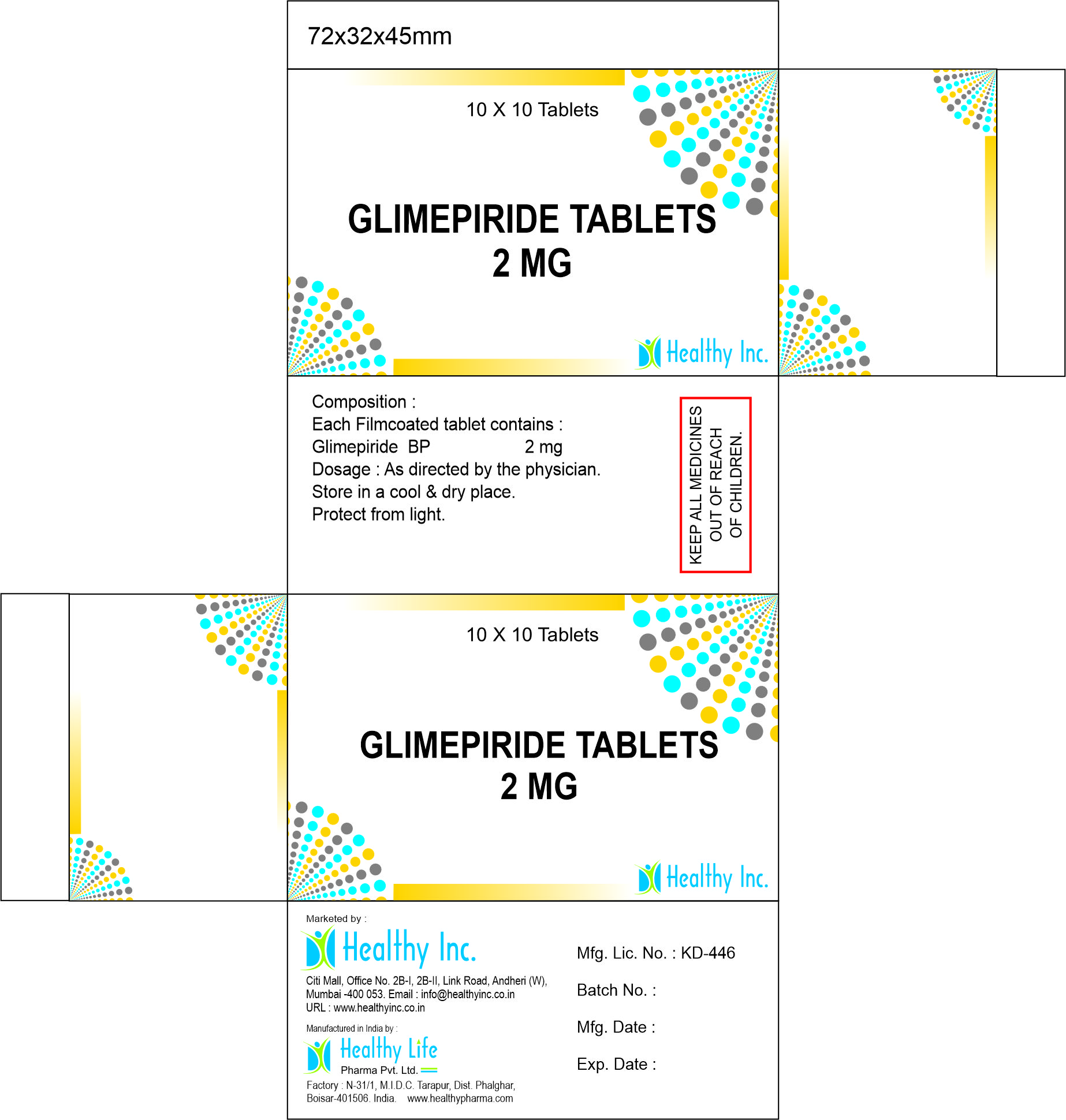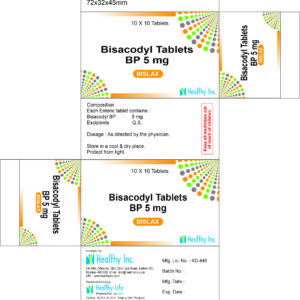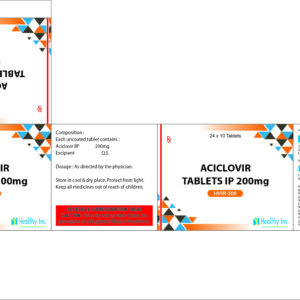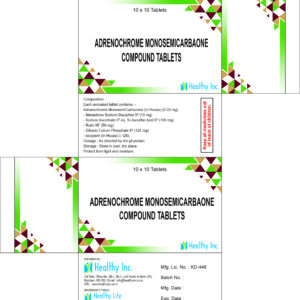Description
Product Description
Glimepiride Tablet
Healthy Incorporation and Healthy life pharma Pvt ltd are one of the leading manufacturer,supplier, and exporter of Glimepiride tablet 1 mg, Glimepiride tablet 2 mg, Glimepiride tablet 4 mg in India and serving the world with the best quality of pharmaceutical products.
Glimepiride tablet Manufacturer
Healthy incorporation and Healthy life pharma Pvt ltd, is Mumbai Based WHO GMP certified manufacturer of injection, tablets, capsules, liquid, dry syrups, pre-filled syringes, ointments etc. with an extensive experience of over 45 years in manufacturing and have reach in many countries. We also supply this tablet in combination Glimepiride + Pioglitazone + Metformin hydrochloride SR tablet (Glimepiride 2 mg + Pioglitazone 15 mg + Metformin hydrochloride 500 mg)
Uses of Glimepiride tablet:
Glimepiride tablets belongs to the group of medications known as sulfonylureas. It helps controlling increased blood sugar which prevents kidney damage, blindness, nerve problems, loss of limbs, and sexual function problems.
Additional Information of Glimepiride tablet:
Product Name Glimepiride tablet
Composition & Active ingredients Glimepiride
Potency 1 mg, 2 mg, 4 mg, Glimepiride 2 mg + Pioglitazone 15 mg + Metformin hydrochloride 500 mg
Therapeutic use Type 2 diabetes
Packing 10 Tablet (1 Box)
Dosage As per Doctor Prescription
Precautions of Glimepiride tablet:
Please inform doctor your medical history, especially of kidney disease, liver disease, any allergy to sulfa drugs,diabetic ketoacidosis, heart disease, enzyme deficiency. Consult your doctor if you are pregnant, or planning to have a baby, or breast-feeding mother.
Side Effects of Glimepiride tablet:
Most of the time there is no serious side effects. Some common side effects may arise after starting medication, as your body adjust to medicine.
Headache
Diarrhea
Sore throat
Skin rashes
Weakness
Confusion
Fever
Difficulty in breathing
Increased hunger
Nausea
Blurred vision
Low blood sugar
Abdominal pain
For Detailed Product Information Contact Us at +91 7710003340, If you need Any assistance in selecting our Products that fits your requirements. If you’re looking for any product that you’re not seeing here, please contact our support team.
Glimepiride Tablet
Glimepiride is a medication that is commonly prescribed to individuals with type 2 diabetes to help lower and control blood sugar levels. It belongs to a class of drugs called sulfonylureas, which work by stimulating the pancreas to release more insulin and by improving the body’s sensitivity to insulin. This helps glucose (sugar) in the blood to be absorbed by the body’s cells for energy.
Here are some key points to know about glimepiride tablet:
Usage: Glimepiride is typically taken orally in tablet form. It is usually prescribed as part of a comprehensive diabetes management plan, which may include lifestyle changes like diet and exercise.
Dosage: The dosage of glimepiride can vary depending on an individual’s specific needs and their response to the medication. It is important to follow your healthcare provider’s instructions regarding the dose and timing of the medication.
Blood Sugar Monitoring: Regular monitoring of blood sugar levels is essential when taking glimepiride. This helps ensure that the medication is working effectively and that blood sugar levels are within the target range.
Hypoglycemia (Low Blood Sugar): Glimepiride can lower blood sugar levels, and this can lead to hypoglycemia (low blood sugar). Symptoms of low blood sugar may include sweating, shaking, rapid heartbeat, dizziness, and confusion. It’s important to be aware of these symptoms and have a plan for managing low blood sugar.
Diet and Exercise: Glimepiride should be used in conjunction with a healthy diet and regular physical activity. Your healthcare provider or a registered dietitian can provide guidance on meal planning.
Side Effects: Common side effects of glimepiride can include weight gain, nausea, and dizziness. More serious side effects are rare but can include severe allergic reactions or a condition called hemolytic anemia. If you experience any unusual or severe side effects, it’s important to contact your healthcare provider.
Precautions: Inform your healthcare provider about any other medications or supplements you are taking, as some drugs may interact with glimepiride. Also, inform them of any allergies or medical conditions you have.
Pregnancy and Breastfeeding: If you are pregnant, planning to become pregnant, or breastfeeding, consult your healthcare provider before using glimepiride. They will help you determine the most appropriate treatment plan during this time.
Storage: Store glimepiride tablets at room temperature in a cool, dry place and keep them out of reach of children.
Please note that this is a general overview of glimepiride tablets, and specific instructions and considerations may vary based on your individual medical history and the guidance of your healthcare provider. Always follow your healthcare provider’s instructions and seek their advice for any questions or concerns related to your diabetes medication.
Glimepiride is an oral medication that is commonly used to treat type 2 diabetes. It belongs to a class of drugs called sulfonylureas, which work by stimulating the pancreas to produce more insulin and by increasing the sensitivity of the body’s cells to insulin. Insulin is a hormone that helps regulate blood sugar (glucose) levels.
Here are some key points about glimepiride tablets:
Indication: Glimepiride is primarily used to lower and control blood sugar levels in people with type 2 diabetes when diet and exercise alone are not sufficient to manage the condition.
How it works: Glimepiride helps lower blood sugar by increasing the release of insulin from the pancreas and by making the body’s cells more responsive to insulin.
Dosage: The dosage of glimepiride will vary depending on individual factors, including the severity of diabetes, overall health, and response to the medication. It is typically taken orally once a day with breakfast or the first meal of the day. The dose should be determined by a healthcare provider.
Side Effects: Like any medication, glimepiride may have side effects. Common side effects include low blood sugar (hypoglycemia), weight gain, and digestive issues. Serious allergic reactions and extremely low blood sugar are rare but possible side effects.
Precautions: It is important for individuals taking glimepiride to monitor their blood sugar regularly and to be aware of the signs of low blood sugar (such as shakiness, sweating, confusion, and rapid heartbeat). It’s important to follow your healthcare provider’s instructions carefully.
Drug Interactions: Glimepiride may interact with other medications, including certain antibiotics, antifungal drugs, and some medications for high blood pressure. Always inform your healthcare provider about all the medications and supplements you are taking.
Pregnancy and Breastfeeding: It is essential to discuss the use of glimepiride during pregnancy and breastfeeding with a healthcare provider, as it may affect the baby.
Alcohol: Alcohol can interact with glimepiride and increase the risk of low blood sugar. It is generally advised to limit alcohol consumption or to avoid it altogether while taking this medication.
Lifestyle Changes: In addition to taking glimepiride, it is important to maintain a healthy diet, engage in regular physical activity, and monitor blood sugar levels to effectively manage type 2 diabetes.
Always consult a healthcare provider or pharmacist for specific information and guidance related to the use of glimepiride tablets. It’s crucial to follow your healthcare provider’s recommendations and attend regular check-ups to manage diabetes effectively and safely.
Glimepiride is a medication used to treat type 2 diabetes. It belongs to a class of drugs called sulfonylureas, which help lower blood sugar levels by stimulating the release of insulin from the pancreas and increasing the sensitivity of cells to insulin.
Here are some key points about glimepiride tablets:
Mechanism of Action: Glimepiride works by binding to specific receptors on the pancreatic beta cells, which leads to an increase in insulin secretion. This, in turn, helps the body regulate blood sugar levels.
Indications: Glimepiride is primarily used to manage type 2 diabetes, especially when dietary and exercise interventions alone are not sufficient to control blood sugar levels.
Dosage: The dosage of glimepiride can vary depending on the individual’s specific needs and their response to the medication. It is typically taken orally, once daily, with breakfast or the first main meal of the day.
Side Effects: Like any medication, glimepiride can have side effects. Common side effects include hypoglycemia (low blood sugar), weight gain, nausea, and dizziness. It’s important to monitor blood sugar levels and report any adverse effects to a healthcare provider.
Precautions: Glimepiride should not be used in people with type 1 diabetes, as it requires some remaining pancreatic function to work. It’s important to inform your healthcare provider about any other medications or medical conditions you have, as they can interact with glimepiride.
Lifestyle Changes: It’s usually recommended to combine glimepiride with a healthy diet and regular exercise to effectively manage type 2 diabetes.
Hypoglycemia: Since glimepiride can lower blood sugar levels, there’s a risk of hypoglycemia. Patients taking glimepiride should be educated on the signs and symptoms of low blood sugar and how to treat it.
Monitoring: Regular monitoring of blood sugar levels and periodic follow-up with a healthcare provider are essential to ensure that the medication is working effectively and to make any necessary dosage adjustments.
Generic Availability: Glimepiride is available as a generic medication, which can be more cost-effective than brand-name versions.
As with any medication, it’s crucial to follow your healthcare provider’s instructions and take glimepiride as prescribed. Do not make any changes to your medication regimen without consulting your healthcare professional, and always seek their guidance on managing your diabetes.
Glimepiride is a medication used to treat type 2 diabetes. It is an oral antidiabetic drug that belongs to the class of medications known as sulfonylureas. Glimepiride helps lower blood sugar levels by stimulating the pancreas to release more insulin and by increasing the sensitivity of cells to insulin.
Here are some key points about Glimepiride tablets:
Indication: Glimepiride is primarily used to manage and control blood sugar levels in people with type 2 diabetes. It is usually prescribed when dietary and lifestyle modifications alone are not sufficient to control blood glucose.
How It Works: Glimepiride works by stimulating the beta cells in the pancreas to produce more insulin and by enhancing the sensitivity of body tissues to insulin. This helps to lower blood sugar levels.
Dosage: The dosage of Glimepiride can vary depending on individual factors like age, weight, and the severity of diabetes. It is typically taken once daily with a meal or as directed by a healthcare provider. It’s essential to follow your healthcare professional’s instructions regarding dosing.
Side Effects: Like any medication, Glimepiride may have side effects. Common side effects include hypoglycemia (low blood sugar), weight gain, nausea, and dizziness. It’s important to be aware of the signs of low blood sugar and take appropriate measures to address it. Serious side effects are rare but can include allergic reactions and liver problems.
Precautions: Before taking Glimepiride, it’s crucial to inform your healthcare provider of any other medications you are taking and any medical conditions you have. People with certain conditions, such as kidney or liver problems, should use this medication with caution. It’s also important to monitor your blood sugar levels regularly as directed by your doctor.
Lifestyle Changes: In addition to taking Glimepiride, lifestyle changes like a healthy diet and regular exercise are essential components of managing type 2 diabetes. Your healthcare provider will likely provide guidance on diet and exercise to complement the medication.
Interactions: Glimepiride may interact with other medications, so it’s important to inform your healthcare provider about all the drugs, supplements, and herbal products you are using to avoid potentially harmful interactions.
Monitoring: Regular check-ups and blood tests are often necessary to monitor your response to Glimepiride and ensure that it is effectively controlling your blood sugar levels without causing adverse effects.
Generic and Brand Names: Glimepiride is available under various brand names, and there are also generic versions of the medication. Your doctor will prescribe the appropriate formulation for your needs.
Please note that this information is meant to provide a general overview of Glimepiride tablets, but you should always consult with a healthcare professional for personalized advice and guidance regarding its use and any specific questions or concerns you may have.
Glimepiride is a medication commonly used to treat type 2 diabetes. It belongs to a class of drugs known as sulfonylureas, which work by stimulating the pancreas to release more insulin and help lower blood sugar levels. Glimepiride helps the body utilize insulin more effectively and can be used in combination with diet and exercise to manage diabetes.
Here are some key points about Glimepiride tablets:
Mechanism of Action: Glimepiride works by increasing the release of insulin from the pancreas and improving the sensitivity of the body’s cells to insulin. This helps to lower blood sugar levels.
Indications: Glimepiride is primarily used to treat type 2 diabetes, particularly in cases where diet and exercise alone are not sufficient to control blood sugar levels.
Dosage: The dosage of Glimepiride can vary depending on individual factors such as the severity of diabetes and the patient’s response to the medication. It is typically taken once a day with breakfast or as directed by a healthcare provider.
Side Effects: Common side effects may include low blood sugar (hypoglycemia), weight gain, and gastrointestinal disturbances like nausea or diarrhea. It’s essential to monitor blood sugar levels regularly while taking this medication.
Precautions: It’s important for people taking Glimepiride to be aware of the risk of hypoglycemia, especially if not eating regular meals. Alcohol can also lower blood sugar and should be consumed with caution. Inform your healthcare provider about any other medications you’re taking, as drug interactions can occur.
Contraindications: Glimepiride is generally not recommended for people with type 1 diabetes, diabetic ketoacidosis, severe liver disease, or those who are allergic to sulfa drugs (as there’s a potential for cross-reactivity).
Monitoring: Regular blood glucose monitoring and medical check-ups are important when taking Glimepiride to ensure that it is effectively managing diabetes and to adjust the dosage as needed.
Lifestyle Changes: Along with medication, lifestyle changes such as a healthy diet, regular exercise, and weight management are crucial in managing type 2 diabetes.
It’s important to note that medication information can change over time, so it’s essential to follow your healthcare provider’s instructions and consult with them for the most up-to-date and personalized advice regarding the use of Glimepiride or any other medication.
Glimepiride + Pioglitazone + Metformin hydrochloride sr tablet
Glimepiride, Pioglitazone, and Metformin Hydrochloride SR (Sustained Release) are all medications used to manage type 2 diabetes. They are often combined in a single tablet to provide multiple mechanisms of action in controlling blood sugar levels. Let me explain each of these medications briefly:
Glimepiride: Glimepiride is a sulfonylurea medication that works by stimulating the pancreas to release more insulin. Insulin is a hormone that helps regulate blood sugar levels by facilitating the uptake of glucose into cells.
Pioglitazone: Pioglitazone is a thiazolidinedione medication that improves insulin sensitivity in the body’s tissues, allowing them to use insulin more effectively. This can help lower blood sugar levels by reducing insulin resistance.
Metformin Hydrochloride SR: Metformin is a commonly prescribed medication for type 2 diabetes. It works by reducing the amount of sugar produced by the liver and also improves the sensitivity of muscle cells to insulin, leading to better blood sugar control. The “SR” stands for sustained release, which means the medication is released slowly over time, helping to maintain stable blood sugar levels.
Combining these three medications in a single tablet can be an effective way to address multiple aspects of diabetes management, such as insulin release, insulin sensitivity, and hepatic glucose production. However, it’s important to note that the use of these medications and their combinations should be determined by a healthcare professional who will consider your individual medical history, diabetes severity, and other factors. Always follow your healthcare provider’s instructions regarding the use of such medications.
Glimepiride, Pioglitazone, and Metformin Hydrochloride SR are medications used to manage diabetes. They are often combined in a single tablet to provide a comprehensive approach to blood sugar control. Here’s a brief overview of each component:
Glimepiride: This is a sulfonylurea medication that helps stimulate the pancreas to release more insulin. Insulin is needed to regulate blood sugar levels, and Glimepiride can be particularly useful for people with type 2 diabetes.
Pioglitazone: Pioglitazone is a thiazolidinedione medication that helps improve insulin sensitivity in the body’s cells. It also reduces the amount of glucose produced by the liver. This medication can be used alongside other antidiabetic drugs to manage blood sugar levels.
Metformin Hydrochloride SR: Metformin is a commonly used medication for type 2 diabetes. It primarily works by reducing the amount of glucose produced by the liver, enhancing insulin sensitivity, and improving the uptake of glucose by cells. The “SR” in Metformin Hydrochloride SR stands for “Sustained Release,” which means it is designed to release the medication slowly over time, providing more stable blood sugar control.
Combining these three medications in one tablet can provide a synergistic effect in managing diabetes. Glimepiride stimulates insulin release, Pioglitazone improves insulin sensitivity, and Metformin helps control blood sugar levels by reducing glucose production and enhancing uptake by cells.
It’s important to note that the use of these medications should be prescribed and supervised by a healthcare professional, as the dosage and combination can vary depending on individual needs and health conditions. Additionally, there can be side effects and contraindications associated with these drugs, so it’s crucial to follow your healthcare provider’s instructions and monitor your blood sugar levels regularly.
Glimepiride, Pioglitazone, and Metformin Hydrochloride SR (Sustained Release) are three different medications that are often used to manage type 2 diabetes. They are sometimes combined into a single tablet to make it more convenient for patients who need to take multiple medications for diabetes control. Here’s a brief overview of each of these drugs:
Glimepiride: Glimepiride is an oral antidiabetic medication that belongs to the class of drugs known as sulfonylureas. It works by stimulating the pancreas to release more insulin and helps to lower blood sugar levels. Glimepiride is typically taken before meals.
Pioglitazone: Pioglitazone is a thiazolidinedione (TZD) that improves insulin sensitivity in the body’s cells. It helps the body use insulin more effectively and can reduce insulin resistance. Pioglitazone is usually taken once daily.
Metformin Hydrochloride SR: Metformin is a widely used oral medication for diabetes management. It works by reducing the amount of sugar produced by the liver and improving the body’s response to insulin. Metformin Hydrochloride SR refers to a sustained-release formulation of metformin. This means the medication is released slowly into the bloodstream over an extended period, allowing for once-daily dosing and potentially fewer gastrointestinal side effects compared to immediate-release metformin.
Combining these three medications into a single tablet can be useful for some patients with type 2 diabetes, as it can simplify their medication regimen and improve adherence. However, the specific combination and dosage should be prescribed by a healthcare professional based on the individual patient’s needs and medical history.
It’s important to follow your healthcare provider’s instructions and take these medications as directed. You should also be aware of possible side effects and any potential drug interactions. If you have questions or concerns about your diabetes medication, it’s best to discuss them with your doctor or pharmacist.
Note: Healthy Incorporation and Healthy life pharma Pvt ltd tries to ensure that all information, whether in relation to the products, services, offerings provided as part of this website is correct at the time of inclusion on the website, Unauthorized use of any materials contained on this website may violate copyright laws, trademark laws, the laws of privacy and publicity, certain communications statutes and regulations and other applicable laws and regulations. All copyright and other intellectual property rights in this material are owned by Healthy Incorporation and Healthy life pharma Pvt ltd. Please connect with us to discuss precise product specifications and requirements and obtain advice on which products are suitable for your requirement or you can write to us
Glimepiride Tablets , ग्लिमेपिराइड गोलियाँ , Comprimidos de Glimepirida , Comprimés de Glimépiride , قرص جليميبيريد ملجم ملجم ملجم , 粒格列美脲錠 毫克 毫克 毫克 , comprimidos de glimepirida , Глимепирид Таблетки , グリメピリド錠, suppliers India, Exporters ,Wholesalers India, Distributors India, Generic Supplier ,who gmp certified manufacturer








